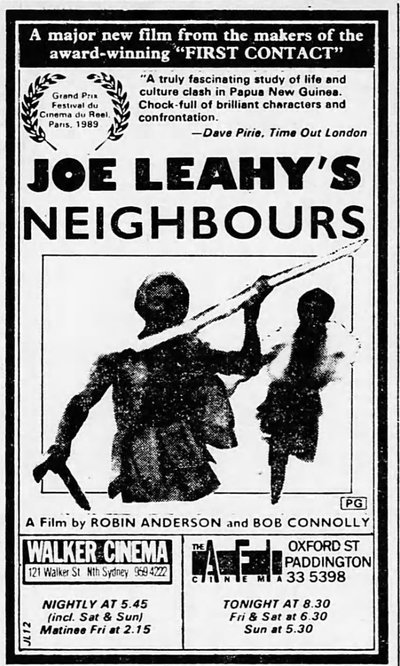This film is the follow-up to First Contact. It traces the fortunes of Joe Leahy, the mixed-race son of Australian explorer Michael Leahy, in his uneasy relationship with his tribal neighbours. Joe built his coffee plantation on land bought from the Ganiga in the mid 1970s. European educated, raised in the highlands of Papua, freed by his mixed race from the entanglements of tribal obligation, Joe leads a Western lifestyle governed by individualism and the pursuit of affluence.Read More »
Ethnographic Cinema
-
Robin Anderson & Bob Connolly – Joe Leahy’s Neighbours [+ Extras] (1989)
1981-1990AustraliaBob ConnollyDocumentaryEthnographic CinemaRobin Anderson -
Makoto Satô – Aga no kioku AKA Memories of Agano (2005)
2001-2010DocumentaryEthnographic CinemaExperimentalJapanMakoto SatôSatō Makoto discovered documentary film when he visited Minamata (well known as the former site of an environmental disaster) as a student, and worked on Katori Naotaka’s The Innocent Sea. While touring Japan with the film, he met people who lived by the polluted Agano River in Niigata and decided to make a film about them. Living there with seven crew members for three years, Living on the River Agano was completed in 1992 and showed people who live with the river and work in agriculture and fishing, quietly probing the cruelty of nature destroyed. Ten years later, and after attending several funerals of people who appeared in the first feature, the team returned to the area. The resulting film Memories of Agano is a ghostly poem on people, fields, stories, songs and buildings receding into absence, the power of images and the strength of sound to revive the past.Read More »
-
Victor von Plessen – Kopfjäger von Borneo aka Headhunters of Borneo (1936)
1931-1940ClassicsDocumentaryEthnographic CinemaGermanyVictor von Plessen
Baron Victor von Plessen’s “Kopfjäger von Borneo” (1936) is a magnificent early ethnographic film. A painter, ornithologist and ethnographer, von Plessen (1900-1980) apparently was an independent spirit of independent financial means. There is absolutely no indication for the fact that this was produced in Third Reich Germany, but this might nevertheless account for the relative obscurity into which this film has sadly fallen.Read More »
-
Nikolaus Geyrhalter – Elsewhere (2001)
2001-2010AustriaDocumentaryEthnographic CinemaNikolaus Geyrhalter
In 2000, the final year of the twentieth century, Nikolaus Geyrhalter and his crew set out with a video camera to film twelve, self-contained ethnographic episodes, each encapsulating a month-long document of the lives of people who perform their quotidian rituals in a figurative Elsewhere, as follow:Read More »
-
Dennis O’Rourke – Cannibal Tours (1988)
1981-1990AustraliaDennis O'RourkeDocumentaryEthnographic Cinema
Quote:Cannibal Tours is a 1988 documentary film by Australian director and cinematographer Dennis O’Rourke. While it borrows heavily from ethnographic modes of representation, the film is a biting commentary on the nature of modernity.Read More »
-
Michael Pilz – Himmel und Erde AKA Heaven and Earth (1983)
1981-1990AustriaDocumentaryEthnographic CinemaExperimentalMichael Pilz
Michael Pilz’s 285-minute Himmel and Erde is an essay film or an ethnographic documentary about life in the Styrian mountain village of St. Anna. It contemplates the finite lot of individuals as part of a continuum of human experience in the natural world. Himmel und Erde, which translates to Heaven and Earth, was recorded between 1979 and 1982. The documentary invites the viewer to contemplate the disruptive effects of technology on economic and social ties through circumscribed vignettes of village life which are oft repeated either as recycled footage or variations on a theme. The film is a meditation on time, nature, and the struggles of man, as well as a record of a lifestyle ceasing to exist. “If you let it happen, the film will pull you into its cosmos; it is one of those works that teaches you to see and listen again.”Read More »
-
Maxine Tsosie & Mary J. Tsosie – Through Navajo Eyes: The Spirit of Navajos (1966)
1961-1970DocumentaryEthnographic CinemaMary J. TsosieMaxine TsosieUSA
Quote:
The Spirit of Navajos
Here the daughters of the chapter chairman of the community decided to make a film showing “the old ways.” They chose their grandfather as subject. He was one of the best known “singers” (medicine men) in the area. The film opens with the old medicine man walking and wandering across the Navajo landscape, again digging and searching for roots and herbs which he is to use as part of a ceremony. We see him at one of the “camps” before a ceremony, eating and drinking. The sequence of the grandfather eating is the only one in which a face close-up is shown. It is apparent, however, that the shot was considered a humorous one, almost like a home movie in which one of the children sticks his tongue out at the camera.Read More » -
Makoto Satô – Agano ni ikiru AKA Living on the River Agano (1992)
1991-2000DocumentaryEthnographic CinemaJapanMakoto Satô

Quote:
In 1964, a chemical factory in Niigata Prefecture dumped mercury into the Agano River, the beginning of a manmade tragedy that would affect locals for years to come. Mercury poisoning led to high occurrences of Minamata disease, a neurological syndrome that causes severe physical and psychological ailments and death. Sato Makoto and his crew of seven spent three years in Niigata documenting the life and thoughts of locals.Read More » -
Alfred Clah – Through Navajo Eyes: The Intrepid Shadows (1966)
1961-1970Alfred ClahEthnographic CinemaExperimentalUSA
The Intrepid Shadows
This is one of the most complex films made by the Navajo. It is the one least understood by the Navajo and most appreciated by “avant-garde” filmmakers in our society. The film opens with a long series of shots showing the varieties of landscape around our schoolhouse. We see rocks, earth, trees, sky, in a variety of shapes but mostly in still or static shots. ’The shadows are very small or short. When we have familiarized ourselves with the things that comprise the “world” we see a young Navajo come walking into the landscape. He picks up a stick, kneels down, and begins to poke at a huge spider web.Read More »

